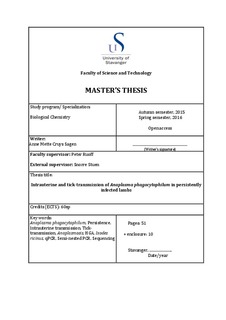| dc.contributor.author | Sagen, Anne Mette Cruys | |
| dc.date.accessioned | 2016-09-26T13:00:16Z | |
| dc.date.available | 2016-09-26T13:00:16Z | |
| dc.date.issued | 2016-06 | |
| dc.identifier.uri | http://hdl.handle.net/11250/2410594 | |
| dc.description | Master's thesis in Biological chemistry | nb_NO |
| dc.description.abstract | The most important tick borne pathogen in animals is Anaplasma phagocytophilum (A. phagocytophilum and the main vector transmitting this pathogen is the tick Ixodes ricinus (I. ricinus). Tick-borne fever and anaplasmosis caused by this bacterium is one of the most common vector borne pathogens in Norway and Europe, A. phagocytophilum is widespread on south western coast areas in Norway. It has been estimated that more than 300. 000 lambs are infected with A. phagocytophilum each year and that it contribute to severe welfare challenges and economic losses for the Norwegian sheep industry
A. phagocytophilum causes a persistent infection in several animal species, which contributes to the transmission and spread of the bacterium. The objectives of this study were to investigate if persistently infected sheep could transmit the bacterium A. phagocytophilum via intrauterine transmittance pathway to its newborn lambs, and in addition to determine if persistently infected sheep could transmit the bacterium to I. ricinus ticks around one year after the primary infection. The study included twelve persistently infected lambs previously inoculated with A. phagocytophilum (M73220) and one uninfected control. The lambs were followed up with measurement of rectal temperature and blood sampling every day the first month after primary infection, thereafter blood were collected monthly. The lambs were mated and nine were pregnant. Blood samples were collected from newborn lambs and from tissue samples if the lamb died. Eleven to twelve months after primary infection the ewes were grafted with nymphs, there were taken blood samples of the ewes and engorged nymphs were collected within 7 days. Blood samples, tissue samples and nymphs were analyzed with real-time PCR (qPCR), if PCR positive the samples were further analyzed by semi-nested PCR. The PCR positive samples from semi-nested PCR were further investigated by sequencing. Thirty percent of newborn lambs were PCR positive (qPCR) including dead lambs. One sample from one newborn lamb was verified for A. phagocytophilum by sequencing. In addition nymphs (33 %) from altogether four lambs were PCR positive. The present study indicates tick transmission and intrauterine transmission of A. phagocytophilum in persistently infected sheep. The persistently infected sheep can carry the bacterium from one grazing pasture to another and to ticks around one year after primary infection. Offspring of persistently infected sheep may also be infected. The importance of these findings for the epidemiology of A. phagocytophilum is unknown and needs to be further investigated. | nb_NO |
| dc.language.iso | eng | nb_NO |
| dc.publisher | University of Stavanger, Norway | nb_NO |
| dc.relation.ispartofseries | Masteroppgave/UIS-TN-IMN/2016; | |
| dc.rights | Navngivelse 3.0 Norge | * |
| dc.rights.uri | http://creativecommons.org/licenses/by/3.0/no/ | * |
| dc.subject | biologisk kjemi | nb_NO |
| dc.subject | Anaplasma phagocytophilum | nb_NO |
| dc.subject | intrauterine transmission | nb_NO |
| dc.subject | qPCR | nb_NO |
| dc.subject | tick - transmission | nb_NO |
| dc.title | Intrauterine and tick-transmission of Anaplasma phagocytophilum in persistently infected lambs | nb_NO |
| dc.type | Master thesis | nb_NO |
| dc.subject.nsi | VDP::Mathematics and natural science: 400::Basic biosciences: 470::Biochemistry: 476 | nb_NO |

